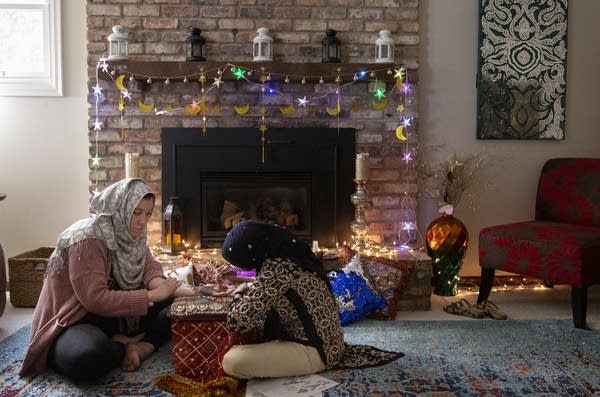Twin Cities henna artist finds culture, religion, fun mix nicely at Eid

Go Deeper.
Create an account or log in to save stories.
Like this?
Thanks for liking this story! We have added it to a list of your favorite stories.
Hajira Begum was homesick and pregnant with her first child when she arrived in Minnesota 11 years ago. She brought with her a few henna cones as a touchstone to her native India.
It didn't take long, though, to see that henna could also help open doors in her new home. "My neighbor, she came and she's like, 'Oh. You do henna,'" Begum recalled.
Now 34, Begum is a sought-after henna tattoo artist, and this time of year she's especially busy with a special clientele: Muslim families. Tuesday is the start of Eid al-Fitr, the religious holiday celebrated by Muslims worldwide marking the end of Ramadan.
Henna is an important part of that celebration for many women who, after a month of fasting, look forward to dressing up and getting henna in preparation for Eid. They also find the beautiful reddish designs can break down barriers between Muslims and people who don't understand their faith.
Turn Up Your Support
MPR News helps you turn down the noise and build shared understanding. Turn up your support for this public resource and keep trusted journalism accessible to all.
And it's fun. A recent gathering at Begum's home found women greeted with snacks and her husband's famous chai. They sat around a fireplace elaborately decorated with lanterns, moons, stars and lights hanging behind beaded, colorful pillows as Begum got to work.

Holding a fine cone, the size of a pen, and with a steady hand, she began drawing a mandala design, a center flower with some intricate fillings. It's like icing a cake — but even more nuanced.
"With Hajira, we don't usually come here with a specific design because she is awesome at freestyling," said Fatma Sheekh, 32, a loyal customer from St. Louis Park. "You have some artists that you just trust that, you know, it's just going to turn out amazing. She's one of those artists."
Begum learned the tradition growing up in India. She makes her own henna from the henna plant, which grows in India and other parts of the world. In the old days, women would dye their hair and nails with the paste because of its natural red color. It's sometimes used for its cooling, relaxing effect.
It only takes her five to 10 minutes to apply the paste. She tells her customers to let it dry for a few hours, then scrape it off, put coconut oil on your hands and you're good to go for a few weeks. The color darkens in the first 24 hours.

The demand for henna art is so high in Minnesota that Begum turned her hobby into an official business. She runs a booth at the Minnesota State Fair. Her summers are booked with appointments for weddings and graduation parties. And this year because Eid falls in June, she's even busier.
She said she charges $10 for a basic henna. The price can go all the way to $200 for the more elaborate bridal designs that take several hours.
"We also tease the bride if you get a darker stain, it means your mother in law loves you — you know, the Indian mother in law," she said. "And some say if you get a good stain, your husband loves you. Every time I get henna my husband gets tense."
The depth of color depends on skin type and even body temperature.
Henna art is at the center of many celebrations beyond marriage.
One memory Desi women of South Asia have tried to keep alive is Chaand Raat, which means "night of the moon" in Hindi. It's a party held on the eve of Eid after moon sightings.

In India, stores stay open all night as people shop for last-minute Eid outfits and get their henna tattoos, Begum said, noting that she wouldn't finish her work until 3 or 4 a.m.
Some Minnesota mosques have tried as much as they can to recreate that feel with similar indoor bazaars.
During this week, Begum will visit with friends and family where henna is sure to be at the heart of all gatherings.

Fahmidha Ameen, 30, of Savage, said when she visits family in India, the first thing she does is gather up her cousins and aunts to get henna.
"When I go home I have a lot of people to take care of my kids," said the mother of two. "So, I spend hours just sitting by myself and I also have my grandmom who feeds me every time I have henna on. I have too many good memories with henna."
Henna can also help build bridges in ways the ancestors would never have imagined.
Sheekh remembered a girls' trip one year to Laguna Beach, Calif., where they came across a few people who were hostile toward them.
"But their kids were incredibly fascinated with our henna and they thought it was real tattoos," she said.
"So, they kept saying, 'You guys are total badasses. That must have hurt so much.' And we were like, 'Yeah totally,'" she said. "That kind of started conversations between us and it wasn't so bad afterwards, it made the parents more comfortable and less afraid."



